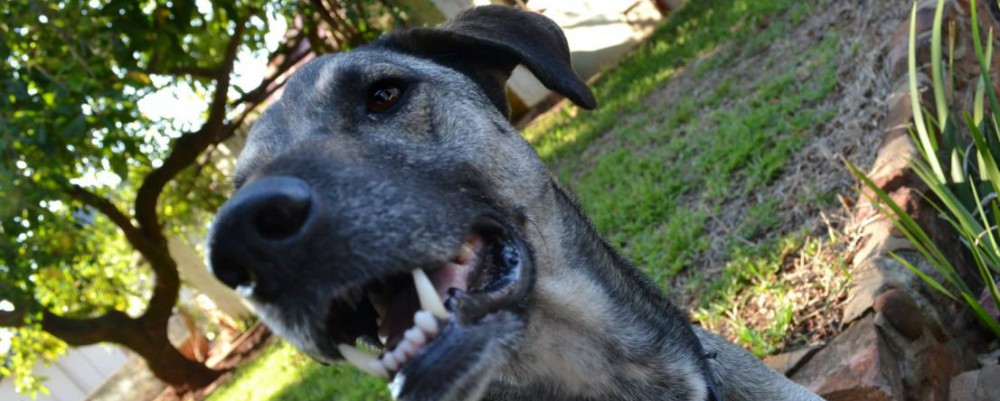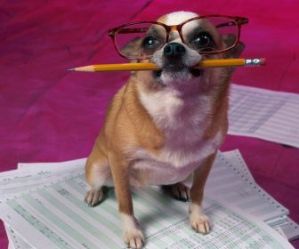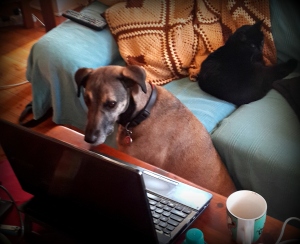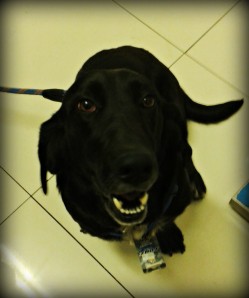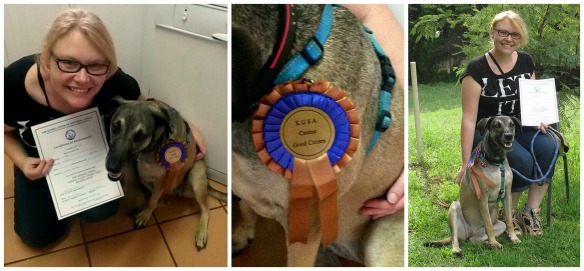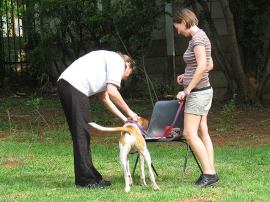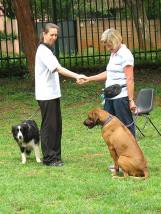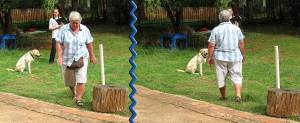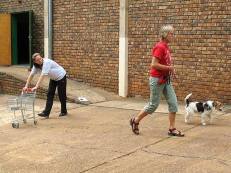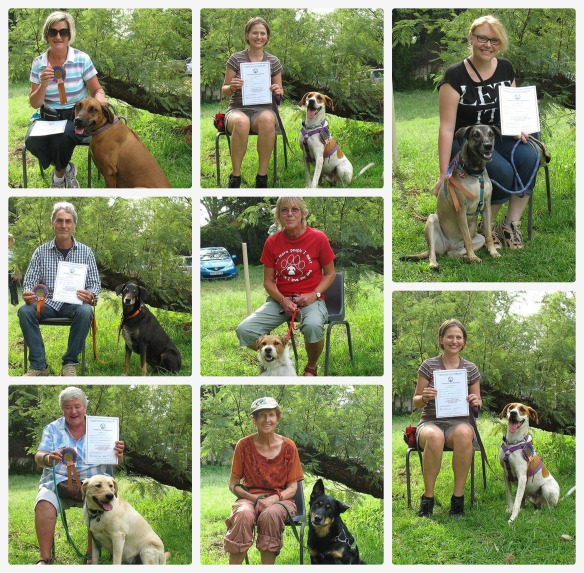So many celebrations over here! Phoebe has made me so proud by going out there and getting her second Canine Good Citizen rosette!
Phoebe has officially received her rosette for passing the Silver Level of the KUSA Canine Good Citizen test!
Some of you may remember when I was so nervous about enrolling her for the Bronze Level KUSA Canine Good Citizen Test – which she passed with flying colours! As a reactive rescue dog seeing her achieve that was beyond my wildest dreams, and then she went ahead and once again overshot all of my expectations making me so very proud.
I once again went into it thinking that it would be totally fine if she didn’t pass first time round, participating is good enough, and I don’t mind a second go at it if we needed it. But of course she did great first time round at everything. But to be honest, I wasn’t quite as nervous this time because the biggest worry is her getting close to other dogs and only the Bronze Level had this one.
For those who aren’t sure what the Canine Good Citizen Test is, it’s an international standard test presented by Kennel Clubs to test if your dog can achieve the basic expectations of a ‘well-mannered’ dog. You can go here to read more about it.
So what did the Silver Test entail?
Similar to the previous test we had to hand over the vaccination cards to be checked before doing anything. Our Evaluator, Mrs Liz Chamberlain, was really nice and made sure we were all at ease with the dogs before starting so that there was no stress on either side of the leash! As she did this she was also walking around and observing the dogs for manners and sociability.
She first started by testing the two Bronze CGC participants (who also did Silver on the same day), and then commenced with testing us all for the Silver Level.
Then we were onto the formal part of the test:
Test 1: Play with Dog
This is to demonstrate that the dog will play with its handler. Play is an extra dimension to a dog’s life and can be a used to make training fun. When instructed to do so the handler should commence to play with the dog. Play should be under the handler’s control and if it involves articles the dog should readily give them up. Formal retrieves will not be deemed as appropriate play.
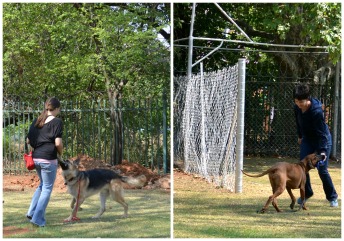
Suki and Mirco play with their Mom’s for Test #1
Test 2: Roadwork
This is to demonstrate that the dog has the ability to walk on lead under control. The handler and dog should walk along a pavement, execute a turn, and then stop at the kerb where the dog should remain steady and controlled. Having observed the Highway Code, they should proceed to the other side, turn and continue walking. Distractions are incorporated, such as normal passing traffic.

All walk in a line around the block to test roadwalking skills
Test 3: Rejoin Handler
This is to demonstrate that the dog will remain steady when the handler leaves the dog but the dog will rejoin the handler when instructed to do so. Having left the dog and moved approximately 10 paces away, when directed to do so, the handler should call the dog. Having rejoined, the dog should stop close to the handler in any position, the lead shall be replaced.
Test 4: Stay in one Place
This is to demonstrate that the dog will stay on the spot while the handler moves away. The handler should place the dog with the lead attached in any position of their choice. Upon instruction, having quietly dropped the lead, the handler will move a distance of 5 paces away for a period of 2 minutes.
*Note we did this in conjunction with Test 10. We took our clipboards, walked a couple of paces away and only when we finished the questionnaire could we rejoin the dogs
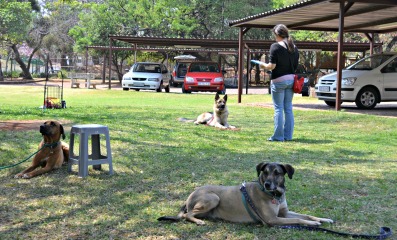
Phoebe, Emily and Mirco eagerly parctice their “stays” for a minumum of 2 minutes while we fill out the Q & A of Question 10
Test 5: Vehicle Control
This is to demonstrate that the handler can get the dog in and out of a vehicle in a controlled manner. Without pulling, the dog should be taken on a lead towards a vehicle and remain steady whilst the handler opens the vehicle door. The dog should not attempt to get in until instructed to and should enter willingly. Thereafter, the door should be closed. The handler, Evaluator and, if necessary, a driver will get into the vehicle. The engine should be started and run for a short time to enable the Evaluator to assess the effect upon the dog which at all times should remain quiet, relaxed, and under control. The dog will then be instructed to exit in an orderly manner.
Test 6: Come Away from Distractions
This is to demonstrate that the handler has control over the dog when there are distractions. The handler should take the dog, on lead, to a gathering of people with dogs also on lead. When instructed to do so, the lead should be removed and the handler should walk or run away calling the dog, which should return without delay and be placed on the lead
For this test we were all placed about 3-5 metres from each other in a loose circle in the shade with us and our dogs in a relaxed lie down, then we had to go through the middle with our dogs. This made me nervous as Phoebe’s reactivity is better, but still there – especially as there were two other dogs doing the test whom we didn’t know. Luckily we were allowed to run through, and not just walk slowly. I’ve learnt this is a key handling trick to keeping Phoebe’s attention on me when other dogs are around because her drive to stay by me when I run away is far greater than worrying about any other dogs she would have to turn away from me to get to. She flew through the path without even registering the 5 other dogs! How awesome is she? 🙂
Test 7: Controlled Greeting
This is to demonstrate that the dog will not jump up at visitors etc, The Evaluator will greet the dog as might be done when entering a house. During this greeting, should the dog jump up, the handler must be able to make the dog cease doing so.
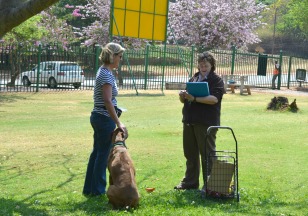
Emily waits patiently as she waits to see what her Mom wants her to do while she greets the evaluator
Test 8: Food Manners
This is to demonstrate that the dog has good manners when aware of peoples’ food. Food should be handled or consumed while the dog, on a loose lead, is taken in close proximity to it. The dog should not unduly respond to this temptation (i.e. not to beg for food or steal).
This is one command our group is usually good at, as we do the “Leave it” command with the dogs regularly, but the evaluator had some treats that were apparently amazingly tempting! All the dogs passed, but only just. I need to find out what those magical treats were!

Those tasty treats were almost irresistible for all of the dogs, but when the tester accidentally dropped them all over the ground Mirco was amazingly controlled. Well done!
Test 9: Examination of the Dog
This is to demonstrate that the dog will allow inspection by a stranger as might be undertaken by a veterinary surgeon. The dog on lead will be required to be placed for inspection of mouth, throat, eyes, ears, and feet when standing, sitting or lying down as required. Other than mild avoidance the dog should allow inspection without concern.

Phoebe calmly stands for her examination
Test 10: Care & Responsibility
This is to demonstrate that the handler has a good understanding of the responsibility required to care for their dog and the responsibility with regards to their neighbors and community. The handler will be asked 6 of the 10 questions by the Evaluator from Section 1 of the non scheduled document titled “Care and Responsibility”.
Learning these 4 pages for the test was very nerve wracking for us! The thing is, the questions are hard, basically because they’re all complete common sense, so it’s easy to forget to mention specific clauses. For example, Dogs Rights is a section of 7 different clauses to remember, included in these is the right to food, the right to water, the right to shade and the right to affection. They’re so straight forward they’re easy to forget!
_____
… and with that, we were all done and we anxiously awaited the results of our test…
And then it happened! She came up to us one by one and we each proudly received the certificates on behalf of our dogs. What a great moment for us all!

Phoebe curiously looks on as I receive her Silver Canine Good Citizen Certificate and rosette on her behalf
We were all so happy for our dogs, and each other! It’s such a rewarding feeling after all that hard work. Each one of us had specific areas of concern for our dogs, but they all shone and performed beautifully!
Do you recommend the Canine Good Citizen (Silver) to others?
I am still a big fan of this test because of all it represents to the dogs and other dog owners. And especially for those who have reactive dogs, getting these qualifications behind you is a real boost for your confidence. The preparation is also great because it gives you very clear and specific goals to tailor play and learning time with the dogs.
I think the Bronze Level is the basic one everyone should go for, but in all honesty, the Silver isn’t too much more difficult, so try getting that too (even on the same day, like two of our class members did!).
Will there be more?
Well, after looking at the requirements for the Gold Level I was adamant that it would be too difficult, but as it now turns out… we’ve decided that all four of us who got the Silver will go ahead and give it a try! Why not? It’ll take a few months of hard training, but we’ll get there, I’m sure!
The evaluator, Mrs Chamberlain, also encouraged us to all enroll for the Gold as she says so few people go on to complete this, and it’s a really nice test to practice for and judge. Looks like we’ll be fulfilling her wish!
And once we do that, who knows, maybe I’ll have time to fit in some training preparation for Cooper to try out since he did so well at his Obedience Class tests! Who knows what the future holds? 🙂
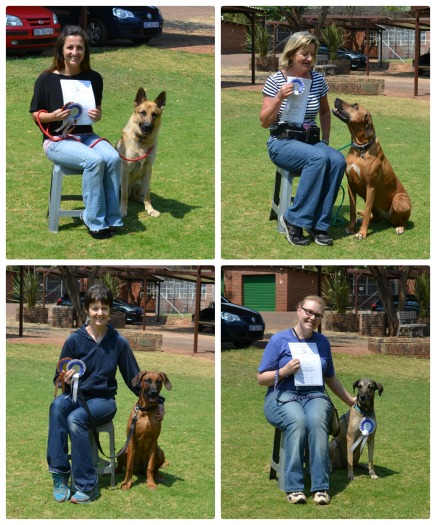
The Canine Good Citizen graduates from “Dog on the Couch” School! The two on the left (Mirco, Suki and owners) got both their Bronze AND Silver, while the two on the right (Phoebe, Emily and owners) achieved the Silver
—
Phoebe’s Effectiveness Summary:
Issue Addressed: Obedience, Focus, Fun
Tool(s) Used: Obedience Training and Behavioural Training
Cost: Moderate (we go to Dog on the Couch school every week, so this can add up depending on your trainer)
Ease of Implementation: Moderate
Phoebe’s Effectiveness Rating: 5/5. Phoebe loves attending her classes, and through these guided lessons we both learn new coping methods and ways to have fun. Preparing for the Canine Good Citizen Test was sometimes difficult and stressful, but ultimately fun and rewarding for us both.
Note: This is a very overdue blog post because we did the test 3 months ago, but better late than never, right?! Practicing for the Gold Level is underway as I type!
—-
Is the Canine Good Citizen Test something you’d be interested in doing with your dog? Do you think your dog would pass easily, or that there would still be a lot more work ahead of you?
